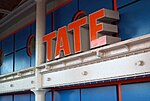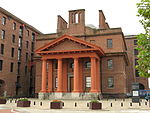International Slavery Museum
2007 establishments in EnglandHistory museums in MerseysideMuseums established in 2007Museums in LiverpoolNational Museums Liverpool ... and 2 more
Slavery museumsUse British English from August 2015

The International Slavery Museum is a museum located in Liverpool, England that focuses on the history and legacy of the transatlantic slave trade. The museum which forms part of the Merseyside Maritime Museum, consists of three main galleries which focus on the lives of people in West Africa, their eventual enslavement, and their continued fight for freedom. Additionally the museum discusses slavery in the modern day as well as topics on racism and discrimination.
Excerpt from the Wikipedia article International Slavery Museum (License: CC BY-SA 3.0, Authors, Images).International Slavery Museum
Hartley's Quay, Liverpool Ropewalks
Geographical coordinates (GPS) Address Phone number Website External links Nearby Places Show on map
Geographical coordinates (GPS)
| Latitude | Longitude |
|---|---|
| N 53.401 ° | E -2.993 ° |
Address
International Slavery Museum
Hartley's Quay
L3 4AQ Liverpool, Ropewalks
England, United Kingdom
Open on Google Maps










